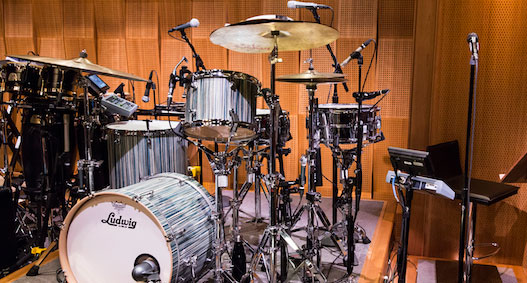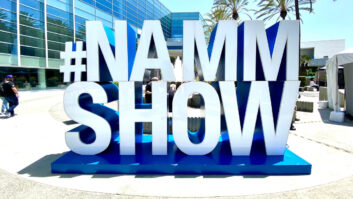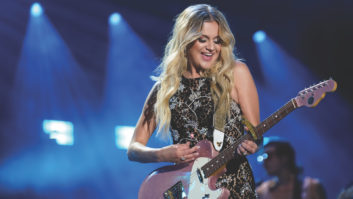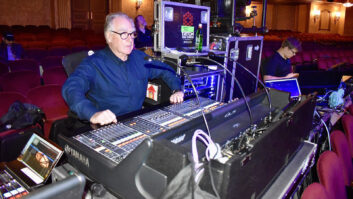
NEW YORK, NY—Music has always been an element of The Tonight Show, but the current incarnation lives and breathes it. Whether it’s because musicians regularly appear in comedy sketches with host Jimmy Fallon, or because three-time Grammy-winners The Roots are the house band, or just because every good party has killer tunes, music has become an essential ingredient.
Bringing those tunes into your home every night is music mixer Lawrence Manchester, and ensuring the studio audience likewise catches every nuance is FOH engineer Nathaniel Hare. Regardless of whether it’s music or comedy coming out of the studio’s PA, getting the audience rocking is a must, because a loud, receptive crowd makes for a better program. “I think it’s a big part of what makes watching the show exciting,” said Manchester, “because there is a sense of ‘Even though I’m not in the room, I’m participating as an audience member in this very real-time experience.’”
An excited crowd doesn’t just add spice to the broadcast mix, said Hare: “My job in the end is to do as much as I can to get the audience in the room engaged, because the more they’re responding and giving feedback to the performers, the better the performances.”
Throughout the show, Hare mixes house sound on three Avid Venue Profile consoles—one for the guest band, one for The Roots and one for production mics. That last desk also takes submixes from the other Profiles and in turn feeds them and its own mixes into a Meyer Sound D-Mitri digital signal processing and distribution system, which sends audio to a range of Meyer self-powered speakers around the studio.
“We also use a Meyer Constellation system which shapes the acoustics of the room as needed,” said Hare. “We can move the acoustic energy of the audience to Jimmy, whether he’s at mono mark or at home base, so that he feels a little bit more like the audience is right with him. That was a very careful system to put in, tune and program; it allowed us to build the room to be as dead as possible and then just flavor to taste where we need a little bit of liveness or crowd.”
Having The Roots on-hand gives the program some extra musical authority, and the band’s presence has helped inform different aspects of the show’s sound, from the microphones to the placement of the musical guests’ monitor console. “We have a different philosophy of how we treat bands,” said Keith McPhee, music supervisor/Roots production manager. “Most shows have one monitor console and they mix from wherever that is. We tried to make this show as artist-friendly as possible, so the guest band monitor console is where it should normally be—next to the band. We also have a monitor console underneath the stage that is for The Roots, so Dan Horton, the monitor engineer, spends most of the show down there, and changes positions to the musical guest console as needed— which is unheard of with most shows.”
Taking care of musical guests sometimes extends to taking longer than a commercial break to get them onstage. “Jimmy’s so into music and is such a musician that it enables us to give people a little bit of leeway that normally wouldn’t happen,” said McPhee. “We do everything—line check, make sure everything’s right— and then we go. Jimmy’s very accommodating when it comes to allowing people time to make sure that stuff sounds great and that they are comfortable before they perform.”
While the show sports a selection of Sennheiser, Shure and Neumann mics for guests, The Roots are Shure endorsees and thus are captured by a variety of mics plugged into Lawo preamps, with lead MC Tariq “Black Thought” Trotter on a KSM9HS, and all backing vocals captured with Beta 58s. Meanwhile, Ahmir “Questlove” Thompson’s drumkit is variously surrounded by a Beta 98AMP on the drum rack; a KSM137 on the Hi-Hat; Beta 181 on snare top and bottom with an additional KSM32 on snare top; and both a Beta 91A and Beta 52 on the kick. Elsewhere around the band are a string of Beta 98AMPs on percussion; KSM32s on sax and guitar; a KSM313 on trumpet; and an SM58S on flute. The band also uses Shure in-ear monitors, opting for ear pieces from Future Sonics for The Tonight Show and from Sensaphonics when on the road.
“The way The Roots use their in-ear monitoring system is pretty unique,” said Manchester. “Yes, that’s how they hear when they’re playing music, but it’s also how they communicate with each other during the show about the next piece of music that they might be doing, or making an audible decision to play different music than what’s on the set list.”
That, in turn, has led to some of the most surprising moments on the show, as Hare recalled: “Bruce Springsteen and Stevie Van Zant were doing a talk segment and mentioned that when they first started playing together down on the Jersey Shore, they’d play a super obscure song they called ‘Wiggle Waggle’ [which was in fact “Wiggle Wobble” by Les Cooper and the Soul Rockers—Ed.]. Questlove’s got a laptop next to him, so he hopped on YouTube, found a clip, played it, the whole band heard it in their ears, figured out the song and then as Jimmy threw to commercial, they started playing and Springsteen jumped up, going ‘Oh my God, the band’s playing “Wiggle Waggle!”’”
The Roots have pulled that trick numerous times since then, said Manchester: “That’s the beauty of having this band doing this show with this host and this infrastructure that allows everyone to move in whatever is the right direction in the moment, where we can depart from the game plan and just go with it because that’s the funny or entertaining thing to do. The fingers are always on the faders, because you never know what’s coming next.”
Shure • Shure.com
Meyer Sound Labs • www.meyersound.com
Avid • www.avid.com






